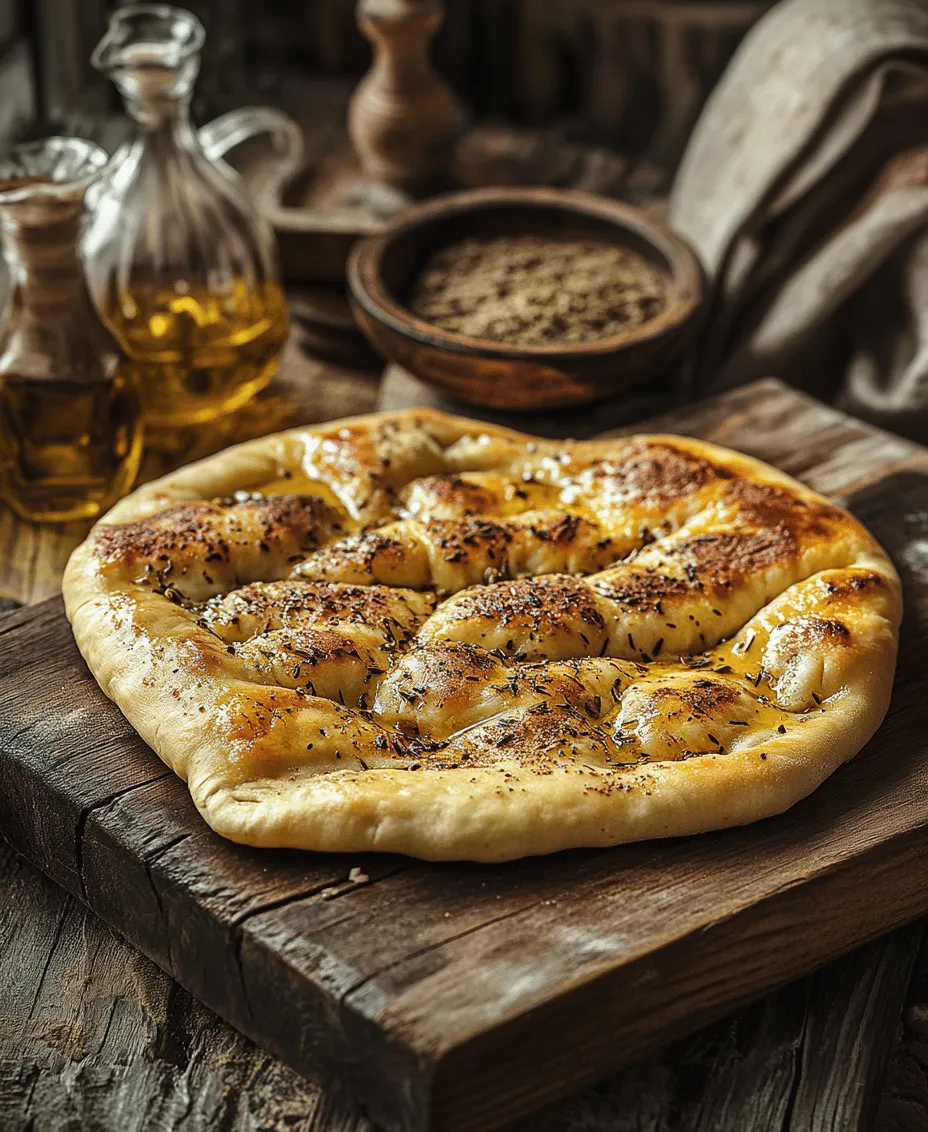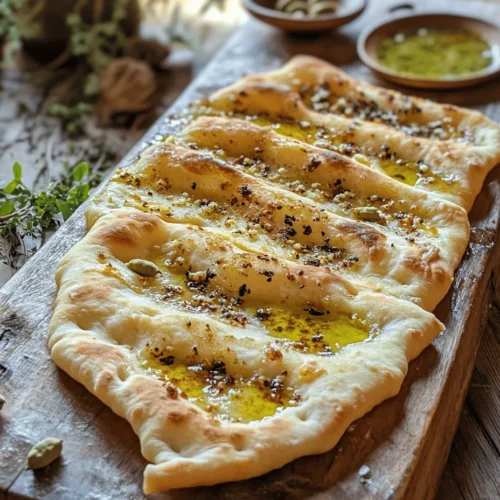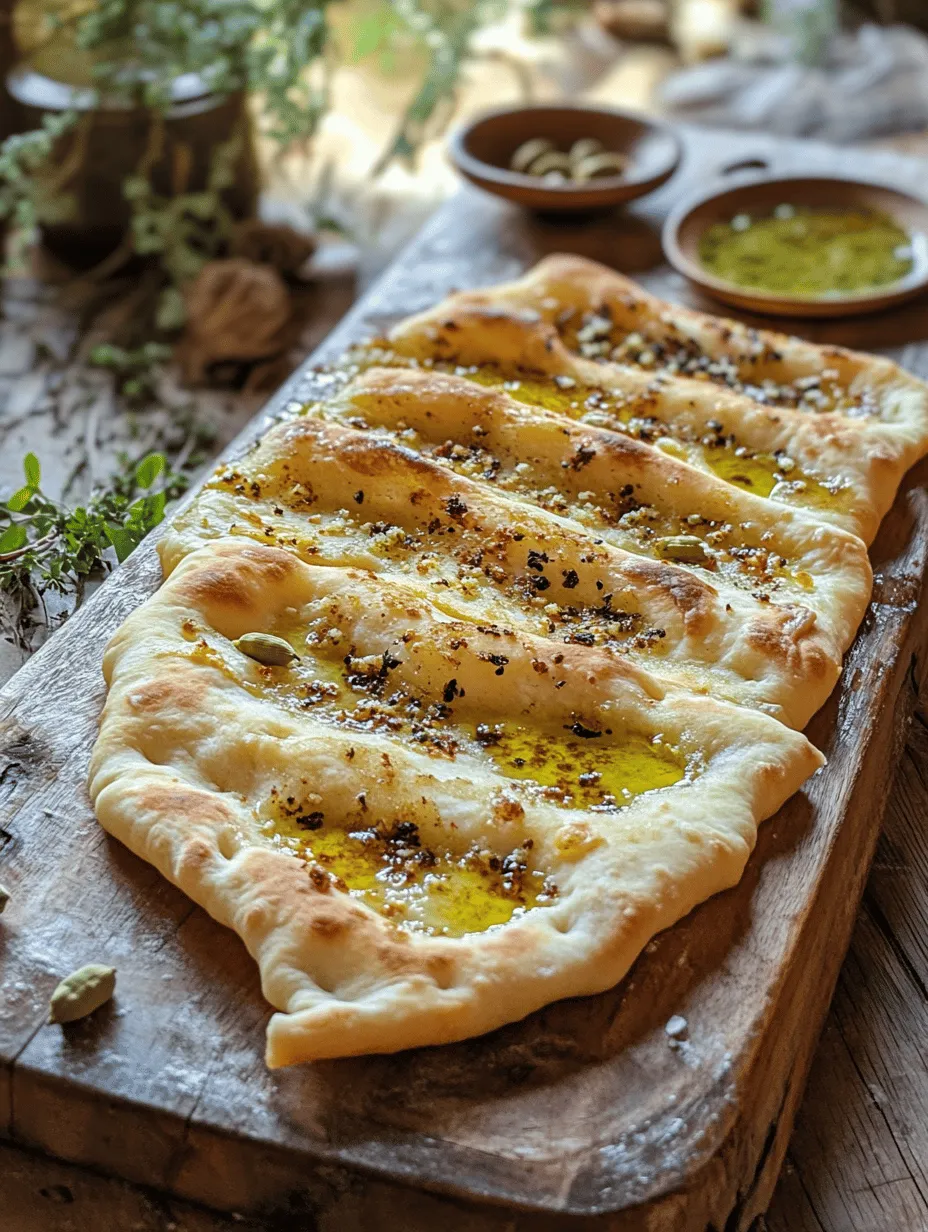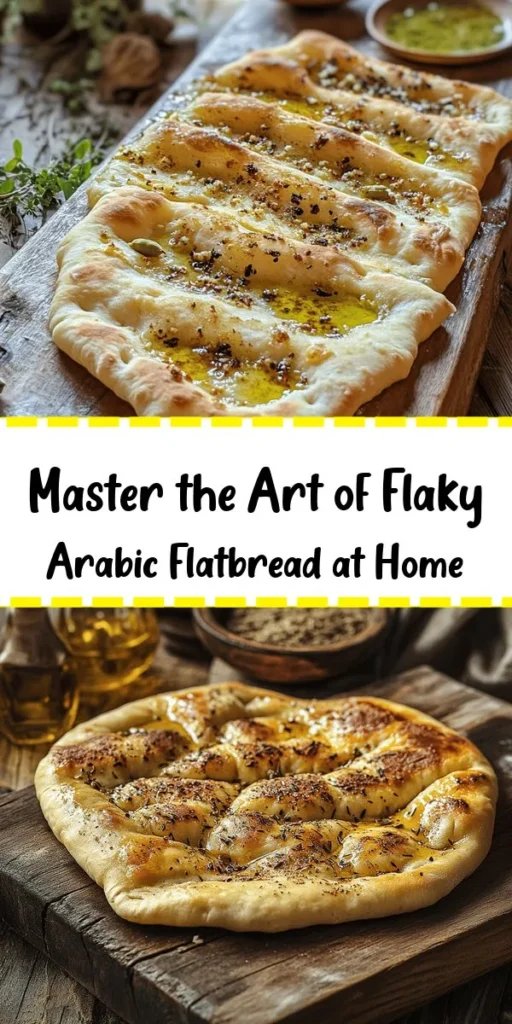Introduction
Flatbreads hold a significant place in Arabic cuisine, revered for their versatility, flavor, and cultural heritage. From the bustling markets of Cairo to the family kitchens of Beirut, flatbreads are not just an accompaniment to meals; they are an essential part of the dining experience. In Arabic culture, flatbreads are often used to scoop up delicious stews, wrap around grilled meats, or simply enjoyed with a drizzle of olive oil and a sprinkle of za’atar. The Flaky Arabic Dough Masterpiece is a celebration of this beloved staple, offering a unique twist that elevates the traditional flatbread experience.
This recipe showcases a flaky, tender dough that can be used in a variety of dishes. Whether you’re making stuffed flatbreads, savory pastries, or simply enjoying them with dips, the possibilities are endless. The dough’s unique texture and flavor profile can be attributed to the careful selection of ingredients and technique, making it a true masterpiece of Arabic cuisine.
What sets this dough apart is its ability to achieve a delicate balance of crispiness and softness, creating a delightful eating experience. The layers of the flaky dough are reminiscent of the best of both worlds, merging the tradition of flatbreads with modern culinary techniques. With each bite, you’ll experience the rich, aromatic flavors that are characteristic of Arabic cooking, making this recipe a must-try for anyone who appreciates authentic cuisine.
Understanding the Ingredients
To create the perfect Flaky Arabic Dough Masterpiece, understanding the ingredients is essential. Each component plays a crucial role in the flavor and texture of the final product.
All-Purpose Flour
At the heart of this dough is all-purpose flour, which provides the necessary structure and elasticity. The protein content in all-purpose flour helps create gluten, allowing the dough to rise and maintain its shape while baking. For those with dietary restrictions, alternatives such as whole wheat flour or gluten-free blends can be used, though they may alter the texture slightly. Experimenting with these alternatives can yield delicious results, catering to various dietary needs while still achieving a flaky texture.
Yeast
Yeast is the leavening agent that brings the dough to life. It ferments the sugars in the flour, producing carbon dioxide that causes the dough to rise. Properly activating the yeast is crucial; using lukewarm water (around 110°F or 43°C) is optimal for yeast activation. Too hot, and it can kill the yeast; too cold, and it won’t activate properly. When you see bubbles forming after mixing the yeast with warm water and a bit of sugar, you know your yeast is ready to work its magic.
Salt and Sugar
Salt and sugar are not just flavor enhancers; they also play vital roles in the dough-making process. Salt strengthens the gluten structure, enhancing the dough’s elasticity and overall flavor. Meanwhile, sugar provides nourishment for the yeast, promoting its growth and enhancing the dough’s sweetness. A small amount of sugar is key to achieving that golden-brown crust during baking.
Olive Oil
Olive oil adds richness to the dough, contributing to its flavor and tenderness. It creates a moist texture and helps in achieving the desired flaky layers. For those seeking healthier alternatives, options like avocado oil or melted coconut oil can be substituted without compromising the dough’s integrity. The choice of oil can subtly influence the dough’s flavor profile, making it a fun aspect to experiment with.
Optional Ingredients: Cardamom and Yogurt
While the basic dough requires only a few ingredients, the addition of cardamom and yogurt can elevate the flavor profile significantly. Cardamom imparts a warm, aromatic quality that is highly prized in Arabic cooking. This spice adds depth to the dough, making it not only delicious but also aromatic. Additionally, incorporating yogurt into the dough enriches its texture and adds a slight tang, creating a soft and pliable dough that is easy to work with.
Step-by-Step Instructions
Now that you have a solid understanding of the ingredients, it’s time to dive into the step-by-step process of making the Flaky Arabic Dough Masterpiece. Follow these instructions for a successful dough that will impress anyone who takes a bite.
Activating the Yeast
The first step in creating your flaky dough is to activate the yeast. Begin by measuring out the warm water and pouring it into a small bowl. Add a teaspoon of sugar to the water, stirring until dissolved. Next, sprinkle the yeast over the surface of the water and allow it to sit undisturbed for about 5 to 10 minutes. During this time, the yeast will begin to bubble and foam, indicating that it is alive and ready to be incorporated into the dough. This activation process is crucial for ensuring that your dough rises properly, resulting in a light and fluffy texture.
Mixing Dry Ingredients
While the yeast is activating, you can prepare the dry ingredients. In a large mixing bowl, combine the all-purpose flour, salt, and cardamom if you are using it. Whisk these ingredients together until they are well combined, ensuring that the salt and cardamom are evenly distributed throughout the flour. It’s essential to achieve a uniform mixture at this stage, as it will impact the overall flavor and texture of your dough.
Combining Ingredients
Once your yeast has activated and you see froth on the surface, it’s time to combine the ingredients. Make a well in the center of your dry mixture and pour in the activated yeast mixture along with the olive oil. Using a wooden spoon or your hands, gently mix the ingredients together until a shaggy dough begins to form. If the dough feels too dry, you can add a tablespoon of warm water at a time until it reaches the desired consistency. Conversely, if it’s too sticky, sprinkle in a little more flour until it’s manageable.
As you mix, visualize the dough coming together, and don’t be afraid to get your hands involved. Kneading is an integral part of dough-making; it develops the gluten structure, ultimately leading to a flaky texture. Once the dough has come together, transfer it to a lightly floured surface and knead it for about 8 to 10 minutes. This process should result in a smooth, elastic dough that springs back when pressed.
By following these steps carefully, you will lay a strong foundation for your Flaky Arabic Dough Masterpiece. The next stages will focus on shaping, resting, and cooking, each crucial for developing the characteristics that make this flatbread so delightful. As we proceed, remember that patience is key; the best dough comes from careful handling and attention to detail.

Kneading the Dough
Kneading is a crucial step in making the perfect flaky Arabic dough. The process develops gluten, which gives the dough its structure and texture. To knead effectively, start by transferring your dough onto a lightly floured surface. Use the heel of your hand to push the dough away from you, then fold it back over itself. Rotate the dough a quarter turn and repeat this process. Aim for a kneading time of about 8-10 minutes until the dough is smooth and elastic.
Techniques for Effective Kneading
1. Use Your Body Weight: Lean into the dough while kneading. This engages your core and helps you work the dough more thoroughly.
2. Incorporate Air: As you knead, make sure to stretch and fold the dough to incorporate air. This will result in a lighter texture.
3. Check for Stickiness: If the dough sticks excessively to your hands or the surface, sprinkle a bit more flour. However, be cautious not to add too much flour, as it could lead to a dense dough.
Signs of Properly Kneaded Dough
The dough is ready when it is smooth and elastic. You can perform the “windowpane test” to check this: take a small piece of dough and stretch it gently between your fingers. If it stretches thin without tearing and you can see light through it, congratulations! Your dough is perfectly kneaded and ready for the first rise.
First Rise
After kneading, the dough needs to rise, allowing the yeast to activate and the dough to expand. This step is critical for achieving that characteristic flaky texture.
Ideal Conditions for Dough Rising
Place the kneaded dough in a lightly oiled bowl and cover it with a damp cloth or plastic wrap to prevent it from drying out. The ideal rising temperature is around 75°F to 80°F. If your kitchen is cool, consider placing the dough in a slightly warm oven (turned off) or near a warm stove.
Visual Cues for When the Dough is Ready
The dough should double in size during the first rise, which typically takes about 1-2 hours. To check if it’s ready, gently poke the dough with your finger. If the indentation remains and does not spring back, it’s time to shape the dough.
Shaping the Dough
Once your dough has risen, it’s time to shape it into portions. This step ensures that each piece cooks evenly, which is crucial for achieving the desired texture in your flatbreads.
Techniques for Portioning and Shaping
1. Divide Evenly: Use a sharp knife or a dough scraper to cut the dough into equal portions. A standard size for flatbreads is about 2 to 3 ounces per piece.
2. Balling the Dough: Shape each portion into a ball by tucking the edges underneath and rolling it gently against the work surface.
3. Resting the Portions: Allow the shaped balls to rest under a damp cloth for 15-20 minutes. This relaxes the gluten, making it easier to roll out.
Importance of Even Portions for Uniform Cooking
Uniform portions ensure that each flatbread cooks at the same rate. If some pieces are larger than others, they may not cook through properly, leading to an inconsistent texture.
Rolling Out the Dough
Rolling out the dough is where the magic happens. Achieving thin, even circles is key for perfect flatbreads that puff up beautifully when cooked.
Tips for Achieving Thin, Even Circles
1. Flour Your Surface: Dust your work surface with flour to prevent sticking. Use a rolling pin to roll out each ball into a circle about 1/8 inch thick.
2. Rotate as You Roll: Frequently turn the dough to maintain a circular shape. This also helps to prevent sticking.
3. Use a Guide: If you’re unsure about thickness, you can use wooden dowels or a rolling pin with thickness guides.
Equipment Suggestions for Best Results
A good quality rolling pin is essential. A marble rolling pin retains cold and helps keep the dough from warming up too quickly, which is crucial for flaky textures. Also, consider investing in a silicone mat, which provides a non-stick surface while making cleanup easy.
Second Rise
After rolling out the dough, a second rise is necessary to achieve the perfect texture.
Duration and Conditions for Optimal Resting
Let the rolled-out dough circles rest for about 30 minutes covered with a damp cloth. This resting period allows the gluten to relax, resulting in a softer, more pliable flatbread.
How This Step Contributes to the Final Texture
The second rise is vital for texture. It allows the dough to aerate further, leading to a lighter and flakier flatbread once cooked. Skipping this step can result in denser, chewier bread that lacks the desired flakiness.
Cooking the Dough
Now it’s time to cook your dough. There are various methods, including using a skillet or an oven, each offering unique results.
Methods for Cooking: Skillet vs. Oven
– Skillet: Heat a cast iron skillet or non-stick pan over medium-high heat. Place the rolled-out dough into the hot skillet and cook for about 1-2 minutes on each side until golden brown and puffed. This method gives you a lovely char and retains moisture.
– Oven: Preheat your oven to 475°F (245°C) or use a pizza stone if available. Place the dough directly on the stone or a baking sheet and bake for about 5-7 minutes. This method can yield a slightly crispier flatbread.
Tips for Achieving the Perfect Golden Brown Finish
– Keep an Eye on It: The cooking time can vary depending on thickness and heat, so watch closely to avoid burning.
– Brush with Ghee or Olive Oil: For added flavor, brush the hot flatbreads with melted ghee or olive oil immediately after cooking.
Serving Suggestions
Flatbreads are incredibly versatile. Here are some creative serving suggestions to enhance your meals.
Pairing Ideas with Dips and Stews
– Dips: Serve your flaky flatbreads with hummus, baba ganoush, or tzatziki for a delightful appetizer.
– Stews: Use them to scoop up hearty stews like lamb tagine or a rich vegetable curry.
Creative Ways to Use the Flatbreads in Meals
1. Wraps: Roll them up with grilled vegetables, meats, or falafel for a delicious wrap.
2. Pizzas: Top with your favorite ingredients and bake for a quick and easy flatbread pizza.
3. Breakfast: Serve them alongside scrambled eggs or as a base for breakfast burritos.
The Cultural Significance of Flatbreads
Flatbreads hold a special place in Middle Eastern cuisine and culture, transcending mere sustenance to symbolize community and tradition.
Exploration of Flatbreads in Middle Eastern Cuisine
From pita to lavash, flatbreads are a staple across the Middle East, serving as a vehicle for dips, stews, and grilled meats. Each region boasts its unique recipes and methods, reflecting local ingredients and culinary traditions.
Historical Context and Variations Across Different Cultures
Flatbreads have been made for thousands of years, with variations found in virtually every culture. For instance, Indian naan, Italian focaccia, and Mexican tortillas all showcase the versatility of this ancient food.
Importance of Flatbreads in Communal Dining
In many Middle Eastern cultures, flatbreads are integral to communal meals, where they are shared among family and friends. The act of tearing bread together fosters connections, making it a symbol of hospitality and togetherness.
Tips for Perfecting the Recipe
To master the art of flaky Arabic dough, consider these helpful tips.
Common Pitfalls and How to Avoid Them
1. Overkneading: This can lead to dense bread. Always check for elasticity without overworking the dough.
2. Too Much Flour: Avoid adding excessive flour while rolling out to maintain the dough’s flakiness.
Variations and Substitutions for Different Tastes
Experiment with different flours such as whole wheat or spelt for a healthier twist. You can also incorporate spices or herbs into the dough for added flavor.
Storing and Reheating Flatbreads for Optimal Freshness
Store cooked flatbreads in an airtight container at room temperature for up to two days. To reheat, wrap them in foil and warm in the oven or skillet to restore their softness.
Conclusion
The Flaky Arabic Dough Masterpiece is not just a recipe; it’s an experience that brings the joy of cooking and sharing to your kitchen. With its versatility, you can pair it with various dishes or use it as a base for creative meals. By mastering this recipe, you have the opportunity to explore the rich heritage of flatbreads and their role in bringing people together. So gather your ingredients, invite friends or family, and enjoy the delightful process of making and sharing these delicious flatbreads. Your journey into the world of homemade flatbreads will surely enrich your culinary repertoire and create lasting memories.



